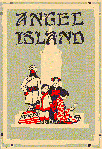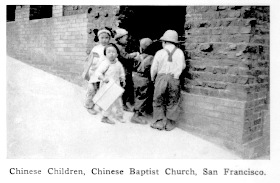


HTML format Copyright © 1998 Louis S. Alfano
All rights reserved.

THE KOREANS
A Korean is a bewildering person, because sometimes he looks like a Chinaman, and sometimesexactly like a Japanese. As a fact, the Korean probably has a right to look like either of them,even if he does confuse a Californian thereby. Rev. James Gale, in "Korea in Transition," says,"in soul the Korean is the son of a Chinaman, but in language he is related to Japan. He cansound both l and r, while the Japanese has to say Gay-roo for girl and the Chinaman saysAmellican for American. The Korean stands between them not in heart and geographicalposition only, but in a still greater sense, we trust, that will be manifest in days to come."
A Bright Young Christian -
Inasmuch as there are only about one thousand Koreans in California, and there are so manymore thousands of Chinese and Japanese, the distributor of Gospels is often taken aback byuncertainty as to the nationality of the person to whom he is speaking. Going over to SanFrancisco one day on the boat from Oakland, a very polite Japanese-looking young man sat nearme, and I ventured to offer him a Gospel in Japanese, but he told me in English that he did notread Japanese.
"Chinese?" I inquired, somewhat bewildered, for he did not look of that nationality.
He was Korean, one of the Methodist Koreans of San Francisco. He told me that the Koreanswere all Christians and that they held meetings twice a week. He was somewhat mistaken, but heevidently found many Christian brethren among them. I asked him if more Koreans would comehere, but he said he thought not, as the government had forbidden their leaving their country. Hehimself had left Korea eight years before, while Korea was an independent nation.
A much more Chinese type of Korean was a man whom I found after the San Francisco disasterof 1906. Following the great earthquake and fire many refugees from San Francisco lived for atime in tents in Oakland. It was a good opportunity to give away Gospels in different languages. A camp of Chinese had been formed among the eucalyptus trees in Beulah Park, East Oakland. Ihad four Gospels in the Korean language, and on inquiry I discovered that there was a Korean ortwo in camp. An obliging Chinaman guided me among the Chinese tents till we came to a tentwhere there was a somewhat elderly Korean, like a Chinaman in height and appearance. ThisKorean received the four Gospels of Matthew, Mark, Luke and John with pleasure, and read to usthe name of each Gospel emphatically aloud, as if pleased to inform us of the sound of themysterious Korean characters on the outside of the paper books.
The Methodist Mission -
The Korean Mission of San Francisco is on Bush street. The two-story dwelling-house bears asign beginning with Korean characters and continuing in English as follows:
Here, during one of the early days of January, 1914, I found the Korean Methodist pastor, Rev.David Lee, who looks like a modest, polite Japanese. His little front parlor was full of littlewhite folding chairs, and he told me that the Koreans were having a meeting daily. There was areed organ in the back parlor upon which was a Korean hymn-book. Mr. Lee, who spoke Englishwell, said that the Presbyterians had charge of the Korean work in Southern California, and theMethodists in Northern California. It is natural that these two denominations should have chargeof the work here, as they do most of the missionary work in Korea itself.
Mr. Lee estimated that about fifty or sixty Koreans came here during 1913. He smiled when Itold him of the Korean young man on the boat, who had said that all the Koreans here wereChristians.
"Not all, but a good many," he gently corrected.
He brought out a number of saffron-colored paper copies in Korea of the Junior catechism of theMethodist Episcopal and the Methodist Episcopal church, South, and other copies of thestandard catechism of the two churches in Korean. The books, of course, began at the back andwent forward like Chinese.
The Bible Society calls San Francisco the center of the Korean population on the coast. During1912, for the first time, the San Francisco branch of the Bible Society received the entire Bible inKorean, and immediately made special efforts to reach the Koreans, engaging for the work Rev.Kwang Y. Lee of the Presbyterian Seminary. Mr. Lee made a tour among the Koreancommunities of San Francisco, Sacramento, Stockton, Alameda and San Jose, and also wroteletter to other Koreans so that, at that time, practically the whole coast was reached. The BibleSociety said, "Of all the foreigners on the coast, perhaps none are more religious than thesepeople. They have strongly appealed to our sympathy and efforts."
Self-supporting Students -
In the Report of the Commissioner General of Immigration for 1914, Mr. Backus writesregarding the Koreans who came here in the year ending June 30, 1914:
"A somewhat noteworthy movement was that of the incoming Koreans, there having been 67applicants of that race during the year (part of them from insular territory) as against 12 fro theprevious fiscal year. Of the total number coming, 37 were students, usually arriving on vesselsunder the American flag, embarking at Shanghai and thereby laying the foundation for the claimthat they are not Japanses subjects and are therfore exempted from the requirement as topassports. none of them will admit the status of a laborer, and in most instances they state thatthey left Korea before or about the time that Japan assumed sovereignty over Korea and thattherefore they are not subjects of Japan. In many cases they are what might be termed "workingstudents" in that they proceed to different educational institutions and actually pursue a studentcourse, but maintain themselves, partially or in whole, by working in some capacity near theschool. The movement has not reached a serious volume at present, but inquiries now coming to us would indicate that it may soon become so large as to require the bureau's special attention."



To get in touch with me send e-mail to
Lou Alfano.
Be
sure to include your full name, as I will NOT reply to
unsigned e-mails.
Please do not write from AOL or Compuserve addresses, because these
ISPs BLOCK e-mail from ".it" domains.
